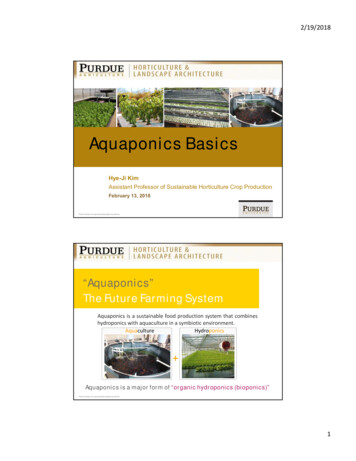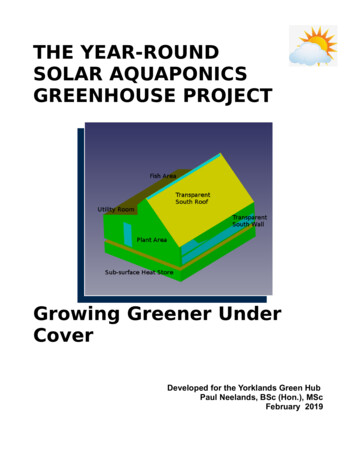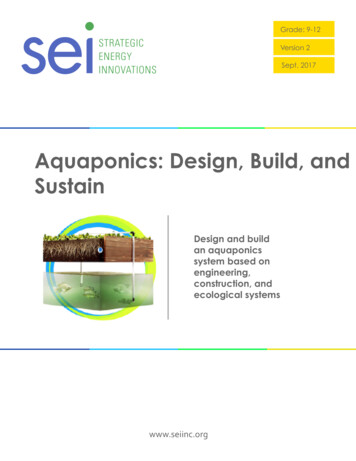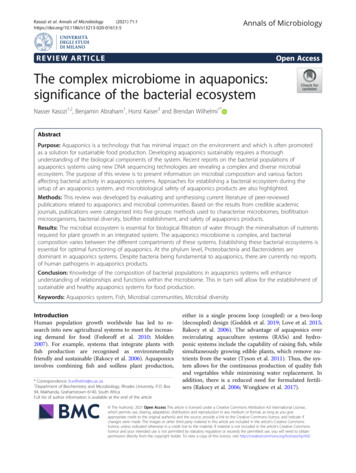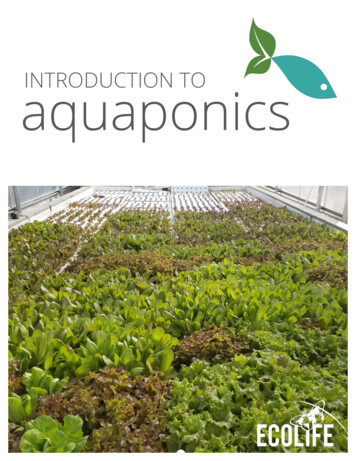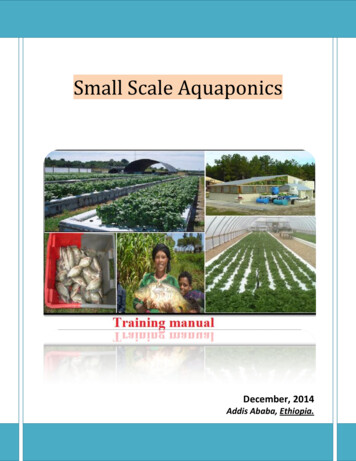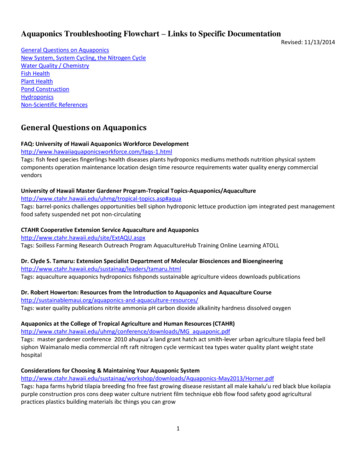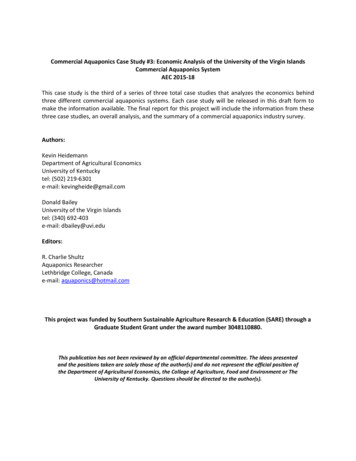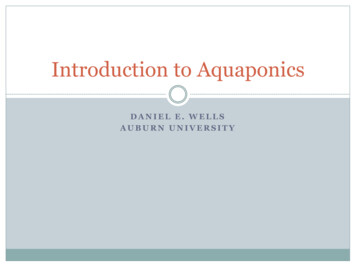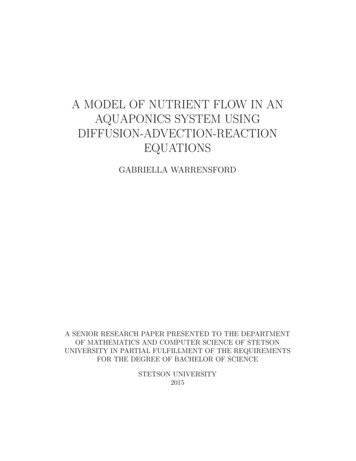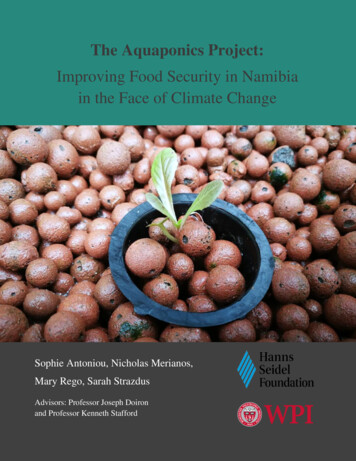
Transcription
The Aquaponics Project:Improving Food Security in Namibiain the Face of Climate ChangeSophie Antoniou, Nicholas Merianos,Mary Rego, Sarah StrazdusAdvisors: Professor Joseph Doironand Professor Kenneth Staffordi
The Aquaponics Project:Improving Food Security in Namibia in the Face of Climate ChangeAn Interactive Qualifying ProjectSubmitted to the Faculty ofWORCESTER POLYTECHNIC INSTITUTEin partial fulfillment of the requirements for thedegree of Bachelor of ScienceBySophie AntoniouNicholas MerianosMary RegoSarah StrazdusDate:13 May 2020Report submitted to:Dr. Clemens von DodererDr. Lara BeerMr. Burton JuliusHanns Seidel FoundationProfessor Joseph DoironProfessor Kenneth StaffordWorcester Polytechnic InstituteThis report represents work of WPI undergraduate students submitted to the faculty as evidenceof a degree requirement. WPI routinely publishes these reports on its website without editorialor peer review. For more information about the project program as WPI, seehttp://www.wpi.edu/Academics/Projectsii
AbstractWe worked with the Hanns Seidel Foundation to improve food security in Windhoek,Namibia with aquaponics. We worked remotely with our sponsors to provide facts sheets,videos, a manual, and a prototype to aid in their Aquaponics Project. These deliverables willeducate Namibians on the benefits of aquaponics and aid in the development of aquaponicsystems throughout the country. We analyzed documents and conducted interviews to create ourdeliverables. We recommend our sponsors adapt our deliverables for use in their other globalproject sites.iii
AcknowledgementsWe would like to acknowledge the many people who contributed to the success of our project.We want to thank Our interviewees, Manny Barra, Paul Mason, Brent Meins, Joe Pate, and Jim Rugarber who weregenerous enough to speak to us over Zoom and email about their aquaponic systems. Theiropenness to share information on why they started using aquaponics, how they built theirsystems, and problems they have encountered greatly impacted our deliverables. It was alsoincredible that they were willing to share photos and videos of their aquaponic systems, it greatlyimproved our understanding of aquaponics.Our sponsors at the Hanns Seidel Foundation, Clemens von Doderer, Lara Beer, and BurtonJulius who continued to work with us on the Aquaponic Project through our inability to travel toNamibia. Their ability to adapt to change and communicate efficiently in a remote environmentallowed us to create a successful project. As well, their constant feedback greatly improved thedesign of our deliverables.Our advisors, Professor Doiron and Professor Stafford for their unwavering support our groupthroughout C and D term. Their flexibility, understanding, and support during the changing IQPexperience and tips on how to work remotely provided us the opportunity to create a successfulproject. We greatly appreciate their creative ideas, such as Pau Hana, to make this unique IQPexperience as normal and meaningful as possible. This project would not have been possiblewithout their constant support and motivation.iv
Executive SummaryIntroductionIn recent years, climate change and drought has negatively impacted Namibia'sagriculture industry. In 2019, the President of Namibia declared a Drought State of Emergency.This drought has caused a 42% decrease in harvest production (UNICEF, 2019). This has haddrastic effects on the food security of Namibians. Nearly 430,000 Namibians were estimated tobe food insecure as of March 2020 (Food and Agriculture Organization of the United Nations,2020). It is important that Namibia takes action to find more sustainable methods of agriculture,such as aquaponics.SponsorsWe worked with the Hanns Seidel Foundation (HSF) in Windhoek, Namibia to creatematerials for their Aquaponics Project. The HSF has project centers in 71 different locations.They were founded in 1967 with the goal of “Service of Democracy, Peace, and Development.”In Windhoek, the HSF works to educate the community on important topics such as climatechange, climate-smart agriculture, and renewable energy. Their current initiative is theAquaponics Project to combat food insecurity in Namibia. For our IQP project, we helped creatematerials that the HSF will use to teach the community about aquaponics.ObjectivesThe goal of our project was to address the food insecurity of Namibia with the use ofaquaponics. We aimed to produce educational information to teach the public about aquaponicsand how they could build their own systems. As well, we wanted to extend this information topeople across the world. To achieve these goals, we completed the following four objectives:1. Provide educational information about aquaponics through fact sheets and videos.2. Create a viable aquaponics prototype design for Namibia to improve food security.3. Create a construction manual infographic and video based on the aquaponic prototypedesign.4. Create a blog that shares information online about aquaponics and our project.v
MethodsData Collection and AnalysisTo create our deliverables, we used qualitative data from online resources and interviews.The online resources used were journal articles, newspaper articles, blogs, educational websites,and government websites. They were found to contain reliable and universal information thatcould be applied to our project. The information we utilized was determined by the specifictopics and leading questions that our sponsors provided for each deliverable. Our team alsoconducted several interviews with current aquaponic growers to gain more practical informationon running a system.To analyze the data that our team collected, we used a process called thematic coding.Thematic coding is the process of identifying common themes throughout the data collected tocategorize the research. This establishes a framework of themes around the central topic, in thiscase aquaponics. These themes were the analysis of the information that we collected throughoutour project and creation of our deliverables for HSF.Deliverable DevelopmentTo create our deliverables, our team used an iterative design process. The iterative designprocess involves establishing what is needed to generate the deliverable, creating the deliverable,and then going through a feedback process. In the feedback process, the deliverable is reviseduntil there are no more improvements, at which time, the final deliverable is produced. From ourobjectives, there were four main deliverables created. These were the blog, the fact sheets andrelated video, an aquaponics prototype design, and a manual infographic and related video.Using the iterative design process for these deliverables, we were able to create successfuldeliverables that fit our sponsor’s needs.FindingsThemesThroughout our project, we gathered information for our deliverables through onlineresearch, interviews, and feedback from our sponsors. Several themes emerged from our analysisof this data. Table 1 shows the four overarching themes of information we found, Purpose,Economics, Yield, and Design, and their corresponding subsets lie underneath. These themesguided the information included in our deliverables.vi
Table 1: Breakdown of themesPurposeFood conomicsInvestmentMarketYieldCropsFishProduction TimeDesignDesign FactorsSystem ParametersDeliverablesWe developed several deliverables for the Hanns Seidel Foundation’s AquaponicsProject. These deliverables exemplify the themes discussed in the previous section. Thedeliverables created were:1.2.3.4.5.6.Fact SheetsVideo Summarizing Fact SheetsAquaponic System PrototypeManual InfographicPrototype Construction Video“Aquaponic Chronicles” BlogThese deliverables can be found on HSF’s website, ThinkNamibia.org.na, and will aid intheir initiative to educate Namibia on sustainable agriculture, as well as, informing the public onthe benefits of aquaponics.DiscussionChallengesDue to the Covid-19 pandemic, our group faced numerous obstacles in the completion ofour project. One major difficulty was the travel restriction, which resulted in us not being able totravel to Namibia. While this was a large challenge, we moved forward with our project andcontinued to work with the Hanns Seidel Foundation remotely from the United States. Thisresulted in small communication issues, as there is a six-hour time difference between ourlocations. However, our team adapted to these challenges and were flexible with thecommunication. We also adapted the framework of the project by implementing more onlinetools, such as creating the “Aquaponic Chronicles” blog, as well as utilizing Zoom to conductinterviews with aquaponics growers.vii
RecommendationsOur team has several recommendations for the future use of our deliverables for theHanns Seidel Foundation. When planning to travel to Namibia and interact with young students,we spoke with a teacher about the best ways to engage students in lessons. The main takeawaywas that the lessons should include games and interactive elements. Therefore, we recommend tothe HSF that students have hands-on experience, so they are more likely to be engaged in whatthey are learning. This can be done by having the students help build the aquaponics system andlater harvest the crops. For the fact sheets, manual, and videos, we recommend that the HSFinclude these within their lesson plans while at the school. We also recommend that thesedocuments are made easily accessible to and be advertised to members of the community whoare interested in learning more about aquaponics to improve food security. Our team alsobelieves the HSF should use these deliverables in more locations than just Namibia as they are aglobal organization with more than 70 worldwide locations and the information in ourdeliverables can be easily modified for different locations allowing for my agriculturalproduction in other food insecure countries. Finally our group recommends the HSF implementour small scale prototype design in some way when constructing a system in a Namibian schoolas it is relatively simple and students would be able to more easily construct it than the largescale design that will currently be installed.Future ImplicationsDue to the COVID-19 pandemic, parts of the HSF’s Aquaponics Project are currently puton hold until quarantine is lifted. Once it is safe to do so, the HSF will continue with their plansto teach and build an aquaponic system in a local Namibian school to allow younger students tolearn more about topics like sustainability, food security, and agriculture. This system will alsoteach the kids about aquaponics and how they could build and maintain a system at home.Although we were not able to work with the HSF as they build the prototype aquaponicssystem, we were able to continue our work with them remotely and provide them with tools toteach individuals about sustainable methods of agriculture. In the future, these materials canprovide tools for anyone to improve their own food security through aquaponics.viii
AuthorshipPaperAbstractAcknowledgmentsExecutive lAllAllAllConstructionMary, NicholasSarah, SophieAllMary, SarahNicholasSophieSarahMaryRevisionsAllSarah, SophieSarah, SophieMaryNicholas, SophieSophieSarahAllDeliverablesFact Sheet #1Fact Sheet #2Fact Sheet #3Fact Sheet VideoPrototype DesignManual InfographicManual VideoBlogix
Table of ContentsAbstract. iiiAcknowledgements .ivExecutive Summary. vIntroduction . vSponsors . vObjectives . vMethods .viData Collection and Analysis .viDeliverable Development.viFindings .viThemes .viDeliverables.viiDiscussion .viiChallenges .viiRecommendations . viiiFuture Implications . viiiAuthorship .ixTable of Contents . xTable of Figures . xiiiList of Tables . xivChapter 1: Introduction. 1Chapter 2: Background . 22.1 Apartheid History . 2x
2.2 Economic Structure. 32.3 Climate Change. 52.4 Namibia’s Agricultural Methods . 52.5 Relocation and Urban Agriculture . 62.6 Relationships . 72.7 Aquaponics and Its Relation to Food Security . 82.8 Various Methods for Aquaponic Systems . 92.9 Benefits of Aquaponics . 112.10 Online Educational Resources . 11Chapter 3: Methodology . 123.1 Team Dynamic . 123.2 Iterative Design . 133.3 Data Collection . 143.4 Data Analysis . 153.5 Deliverables . 153.5.1 Blog . 153.5.2 Fact Sheets and Video . 163.5.3 Prototype Design . 163.5.4 Manual Infographic and Video . 17Chapter 4: Findings . 184.1 Themes . 184.1.1 Purpose . 184.1.2 Economics . 214.1.3 Yield . 224.1.4 Design . 244.2 Deliverables . 25xi
4.2.1 Fact Sheets . 254.2.2 Video on Fact Sheets . 274.2.3 Aquaponic System Prototype . 284.2.4 Manual Infographic . 294.2.5 Manual Video . 304.2.6 “Aquaponic Chronicles” Blog. 31Chapter 5: Discussion . 335.1 Challenges . 335.2 Future Recommendations . 335.3 Future Implications . 34Chapter 6: Conclusion . 35References . 37Appendices . 40Appendix A: Interview Guide. 40Appendix B: Fact Sheet #1 . 41Appendix C: Fact Sheet #2 . 45Appendix D: Fact Sheet #3 . 49Appendix E: Manual Infographic . 53Appendix F: Links . 54xii
Table of FiguresFigure 1: Aquaponics system cycle . 9Figure 2: Nutrient Film Technique System . 10Figure 3: Media-based System . 10Figure 4: Deep Water Culture System. 10Figure 5: Our Trello Dashboard . 13Figure 6: Iterative Design Process . 14Figure 7: Timeline for the blog . 15Figure 8: Timeline for the fact sheets and video . 16Figure 9: Timeline for prototype and manuals . 17Figure 10: First page of all three fact sheets . 26Figure 11: Feedback on first draft of fact sheet #2 . 26Figure 12: Feedback on first draft of fact sheet #3 . 27Figure 13: Video stills from first draft of the fact sheet video . 27Figure 14: Video stills from final draft of the fact sheet video . 28Figure 15: First design of the aquaponic system prototype . 28Figure 16: Final design of the aquaponic system prototype . 29Figure 17: Images on infographic showing to show construction steps. 29Figure 18: Updated images on final manual infographic . 30Figure 19: Video stills from final manual video . 30Figure 20: Homepage of blog . 31Figure 21: Example section of blog post . 32Figure 22: Blog section . 32xiii
List of TablesTable 1: Breakdown of themes . 18xiv
Chapter 1: IntroductionNamibia has been facing its worst drought in several decades, with a Drought State ofEmergency being declared in 2019 (UNICEF, 2019). Namibia's agriculture industry, whichaccounts for 31% of the labor force, is greatly impacted by this drought (Central IntelligenceAgency, 2020). In recent years, crop yields have been low due to low amounts of rain. In 2013,the drought killed 4,000 animals and affected nearly 300,000 people (UNICEF, 2019). Asclimate change continues to affect the agriculture industry, Namibia becomes more reliant onfood imports and food security continues to worsen. An estimated 430,000 Namibians are in theCrisis or Emergency stages of food security (Food and Agriculture Organization of the UnitedNations, 2020). New and innovative agriculture methods are needed to improve these worseningconditions in Namibia.The Hanns Seidel Foundation (HSF) is looking to promote sustainable agriculture inNamibia to help improve food security. Aquaponics, when used in addition to hydroponics andtraditional agriculture, would greatly improve the food security of many Namibians. This isbecause aquaponics provides leafy greens and fish in a sustainable and water efficient system.Due to the ongoing drought in Namibia and the arid climate, water is scarce in the country. In2019, the drought caused a low harvest that severely affected subsistence farming. This led tofood insecurity worsening in early 2020 (Food and Agriculture Organization of the UnitedNations, 2020). The effects of the drought show that it is imperative for Namibia to implementclimate-smart agriculture practices. By changing current methods of agriculture to a more waterefficient and climate resistant method such as aquaponics, rural Namibians can improve theirfood security.Several efforts in Namibia have addressed issues caused by climate change on foodsecurity and agriculture. Namibia’s Climate Change Policy strives to protect the agricultureindustry by achieving sustainable agriculture production. The policy does this by promotinghighly adaptive breeds of livestock and crop cultivars, conservation agriculture and ecologicallycompatible cropping systems, and agricultural production that will best maintain and improvehousehold income (Ministry of Environment & Tourism, 2011). Climate-smart agriculture, oragricultural methods that can provide sustainable food security within the effects of climatechange, has been promoted by the Food and Agricultural Organization of the United Nationsand the HSF (Food and Agriculture Organization of the United Nations, 2020). These efforts areworking towards improved agriculture methods for Namibia while it faces the harsh effects ofclimate change.Although these efforts are working towards a similar goal of improving agriculturemethods in Namibia, none fully address aquaponics. Aquaponics is a sustainable method ofagriculture that is perfect for dry and arid climates such as Namibia. It is more water efficientthan traditional agriculture methods and can provide better crops during the drought. Promotingaquaponics in Namibia will create a new type of climate-smart agriculture for them to utilize.1
The goal of this project was to create educational materials and a prototype system topromote the use of aquaponics in Namibia. This goal was achieved through four main objectives.We first created educational materials in the form of fact sheets and videos, developed aprototype aquaponics system, created a manual infographic and video of the system, anddeveloped a blog to share aquaponics information. This information was shared on the HSF’swebsite, ThinkNamibia.org.na, as part of their aquaponics project initiative. It provides all theinformation needed for Namibians to learn about aquaponics and build your own system. Thesedeliverables will aid in improving Namibia’s food security in the face of climate change.Due to the COVID-19 pandemic, we were unable to travel to Windhoek, Namibia tocomplete the project. We have altered parts of the project to complete as much as we canvirtually. The fact sheets, informational video, and infographic have remained the same.Originally, the prototype aquaponic system was to be built in a rural Namibian school as ateaching material and to provide the students with food. Due to the lockdown in Namibia, weinstead developed a design in CAD to create the infographic and video manuals. This will allowthe Hanns Seidel to have the materials needed to teach and build aquaponics systems in Namibiawhen possible. As well, we added a blog to our project due to the implications of COVID-19.We saw a great opportunity to share information online during this time. We used this tointerview several aquaponic hobbyists and share what they have done to spread the knowledgeand benefits of aquaponics. Despite these unpredictable changes, we were still able to provideuseful deliverables for the HSF to use when promoting the use of aquaponics in Namibia.Chapter 2: Background2.1 Apartheid HistoryTo understand how Namibia’s agriculture system has been shaped, it is important tounderstand Namibia’s Apartheid history. As Namibia started to seek independence from SouthAfrica in the late 1900s, the country faced a series of challenges which impacted the economy,employment rates, and food security. Namibia became fully independent in 1990 after a longhistory of discriminatory and corrupt ruling. The discrimination and corruption left behind bySouth African rule has resulted in a lack of jobs and insufficient food for Namibians today.Before independence, Namibia was a part of South Africa but divided into an “Apartheid State,”meaning “Separate State” in Afrikaans. This left Namibia in a segregated state that discriminatedagainst native Africans. This inequality was the basis of the government and was a guidingprinciple throughout the country which inevitably led to economic disadvantages. The impacts ofthis discrimination can still be seen today, as South Africa left the newly independent country ina fiscal crisis, d
1. Provide educational information about aquaponics through fact sheets and videos. 2. Create a viable aquaponics prototype design for Namibia to improve food security. 3. Create a construction manual infographic and video based on the aquaponic prototype design. 4. Create a blog that shares information
